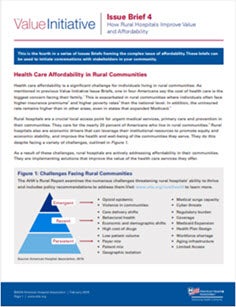Issue Briefs
AHA's Issue briefs frame the issue of affordability and can be used by hospitals and health systems to initiate conversations with stakeholders in their communities.
 | Measuring the Value of Team-based Care: A Dashboard for Health Care OrganizationsLearn about real-life examples of hospitals that have utilized team-based care to improve value. This dashboard deeper provides health care leaders with metrics that their organizations can use to make the case for team-based care. It demonstrates the value of team-based care in four domains: process and culture; quality and outcomes; patient experience; and costs. |
 | Creating Value by Bringing Hospital Care HomeAs hospitals consider how and where they deliver care to patients, many are seeing the hospital-at-home model as a promising approach to improve value. This issue brief explores how hospitals can provide acute-level care in patients’ homes, and highlights case examples of hospitals that successfully improved value through their home hospital programs. |
 | Team-based Care Creates ValueTo better support patients and their families through an acute or chronic illness, hospitals are adopting team-based models of care that encompass patients’ medical and social needs across the care continuum. Team-based care is a promising, low-tech approach that allows health care workers from varying professional disciplines to provide customized, patient-centered care to manage the physical, psychological and spiritual needs of their patients. This issue brief also highlights AHA Team Training and discusses how hospitals have utilized care teams during the COVID-19 pandemic. |
 | Creating Value with Age-Friendly Health SystemsWith the number of older adults in the United States projected to double in the next 40 years, hospitals and health systems are adapting low-tech, value-based strategies to improve patient outcomes for older adults. This issue brief highlights ways that age-friendly care’s 4Ms Framework and measures enable value, along with case examples and considerations for becoming an Age-Friendly Health System. |
 | Creating a High-value Telehealth StrategyThis issue brief examines how hospitals and health systems are utilizing telehealth to improve patient outcomes and the patient experience, and reduce cost. It looks are barriers to widespread adoption as well as AHA advocacy efforts. The brief also discusses ways to tailor an organization’s telehealth strategy to meet patient and community needs. |
 | Low-tech Solutions that Advance ValueAs hospitals and health systems implement value-based strategies, they also are adopting innovative, low-tech approaches to improve value. This issue brief examines characteristics of low-tech solutions and includes examples of hospitals implementing several low-tech approaches. Beginning in 2020, as part of The Value Initiative’s From Paper to Action effort, the AHA will focus on widespread implementation of four specific low-tech value-based strategies. |
 | Integrated Behavioral Health is High-value CareIntegrating physical and behavioral health care services can help hospitals and health systems overcome patient barriers to accessing behavioral health services while improving outcomes and value. This issue brief examines how integration can take various forms based on provider, patient and community needs and how telebehavioral health can help in areas with shortages of behavioral health professionals. The brief also provides examples from specific hospitals and health systems and links to additional AHA behavioral health resources. |
 | Framing the Issue of Affordable Health CareAffordability is one of the most important challenges influencing Americans’ ability to access health care. A number of factors affect the affordability of health care, including housing, transportation, education, personal choices, and the cost of health insurance, prescription drugs, and hospital services. Leaders from the American Hospital Association, hospitals, and health systems understand these challenges, have strategies to address them, and are deeply committed to ensuring that patients and consumers have access to affordable health care. |
 | What Does Value Mean?There has been significant interest in and discussion around what value in health care delivery means. Yet, despite an increasing focus on value, there is no agreed-upon definition or expectation across the health care field. Perspectives vary widely, are at times inconsistent and, in many instances, do not align amongst various stakeholders involved with the delivery of health care. In this issue brief, we identify various definitions of value, explain why it is so difficult to define, and share how the AHA intends to address the value equation. |
 | Connecting the Dots: Value and Health EquityHow are value and health equity connected? The best way to examine the connection between health equity and value is to start by understanding health equity. Health equity is achieved by providing care that does not vary in quality by personal characteristics such as gender, ethnicity, geographic location and socioeconomic status. Therefore, achieving health equity requires a concerted effort to increase opportunities to be healthier for everyone, including those for whom obstacles are the greatest. Research has shown that improvements in health equity can provide tremendous value to patients, hospitals and the health care delivery system. And, hospitals and health systems are employing a number of approaches to improve health equity and promote value. |
 | How Rural Hospitals Improve Value and AffordabilityRural hospitals are a crucial local access point for urgent medical services, primary care and prevention in their communities. Despite multi-faceted and complex challenges, rural hospitals continue to transform and adapt to meet the needs of their populations. This Issue Brief highlights four strategies rural hospitals are using to improve value by reducing cost, improving quality or enhancing the patient experience. |
 | Improving Value for Patients with a Serious IllnessThe U.S. spends $909 billion annually on patients with serious illness, such as cancer, COPD or dementia. Palliative care – a specialized care model for individuals living with serious illness - is an effective approach to address patients’ medical and psychosocial needs while reducing cost. It is based on the patient’s needs, not prognosis. This Issue Brief examines how a palliative care promotes value for patients, hospitals and communities, and includes case examples and resources. |

